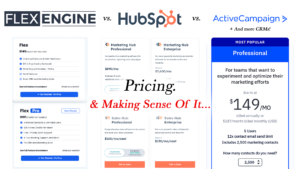In the dynamic landscape of Customer Relationship Management (CRM), choosing the right platform is crucial for businesses of all sizes. Two contenders in this arena, Flex Engine vs Keap, offer unique features and functionalities designed to streamline operations, enhance customer interactions, and drive growth. In this comprehensive comparison, we will delve into the similarities, differences, and standout features of Flex Engine and Keap, aiming to guide businesses toward the CRM solution that aligns best with their needs.
Understanding Flex Engine
Flex Engine Overview
Flex Engine, a relatively new player in the CRM space, has garnered attention for its flexibility and scalability. It positions itself as a comprehensive solution catering to businesses ranging from startups to enterprises. Flex Engine emphasizes adaptability to various industries, providing a versatile platform to manage customer relationships, streamline marketing efforts, and optimize sales processes.
Flex Engine is a powerful tool designed to meet the diverse needs of businesses across industries. With its emphasis on adaptability, this platform enables enterprises to effectively manage customer relationships, streamline marketing efforts, and optimize sales processes. From customer acquisition to retention, Flex Engine offers a comprehensive suite of features that cater to the unique requirements of each business.
One of the key strengths of Flex Engine lies in its ability to integrate seamlessly with existing systems and processes. Whether it’s integrating customer data from different sources or aligning with marketing automation tools, Flex Engine ensures a smooth flow of information and efficient operations. This flexibility enables businesses to leverage their existing investments and leverage the power of the platform without disrupting their established workflows.
Additionally, Flex Engine boasts a user-friendly interface, making it easy for businesses to navigate and utilize its functionalities. The platform provides real-time insights and analytics, allowing businesses to make data-driven decisions and understand customer behavior better. With features such as lead management, marketing campaign optimization, and sales funnel analysis, Flex Engine equips enterprises with the tools they need to drive growth and maximize their revenue potential.
Best Features of Flex Engine
Adaptive Customization:
-
- Similarities with Keap: Flex Engine shares a common ground with Keap in its emphasis on customization. The platform allows businesses to adapt CRM processes to their specific needs, ensuring a tailored approach to customer management.
-
- Key Differentiator: Flex Engine takes customization to the next level with dynamic modules and fields, enabling users to mold the CRM according to evolving business requirements seamlessly.
Cutting-Edge Technology:
-
- Similarities with Keap: Flex Engine shares a common ground with Keap in its emphasis on customization. The platform allows businesses to adapt CRM processes to their specific needs, ensuring a tailored approach to customer management.
-
- Key Differentiator: Flex Engine takes customization to the next level with dynamic modules and fields, enabling users to mold the CRM according to evolving business requirements seamlessly.
Unified Data Management:
-
- Similarities with Keap: Both Flex Engine and Keap recognize the importance of a unified data management system. They offer features to consolidate client data, interactions, and communication within a centralized hub.
-
- Key Differentiator: Flex Engine introduces a unique data fusion capability, breaking down silos between traditionally separate datasets. This fosters a holistic understanding of customer interactions, allowing businesses to make informed decisions.
Scalability and Performance:
-
- Similarities with Keap: Scalability is a shared trait between Flex Engine and Keap. Both platforms accommodate the growth of businesses, ensuring that the CRM system scales in tandem with expanding needs.
-
- Key Differentiator: Flex Engine introduces a performance optimization algorithm that dynamically adjusts resources based on usage patterns. This ensures optimal system performance even during peak usage, setting it apart in terms of efficiency.
Advanced Analytics and Reporting:
-
- Similarities with Keap: Analytics and reporting are integral components of modern CRMs. Flex Engine and Keap provide tools for generating insights, measuring performance, and identifying areas for improvement.
-
- Key Differentiator: Flex Engine’s analytics module leverages machine learning algorithms to predict future trends based on historical data. This forward-looking approach enhances the platform’s utility for businesses aiming to stay ahead of the curve.
Understanding Keap
Keap Overview
Keap, a well-established CRM solution, caters to businesses seeking a comprehensive platform that integrates customer management, marketing automation, and sales optimization. Known for its user-friendly interface and diverse feature set, Keap positions itself as an ally for businesses aiming to organize, automate, and grow. Keap is a powerful software solution that offers a comprehensive suite of tools for marketing automation and sales optimization.
One of the key strengths of Keap is its marketing automation capabilities. This allows businesses to automate repetitive tasks such as lead capturing, email marketing, and customer follow-ups. By automating these processes, businesses can save time and effort, while also ensuring that no leads slip through the cracks.
Overall, Keap provides a robust and user-friendly platform for businesses of all sizes to manage their marketing and sales efforts. With its array of features and emphasis on automation and organization, Keap is an invaluable tool for businesses looking to streamline their operations and drive growth in an increasingly competitive marketplace.
Best Features of Keap
Contact Management Excellence
-
- Similarities with Flex Engine: Both Keap and Flex Engine recognize the significance of effective contact management. They provide tools to organize, segment, and engage with contacts efficiently.
-
- Key Differentiator: Keap’s lead scoring system stands out, allowing businesses to prioritize and focus efforts on leads with the highest likelihood to convert. This enhances the efficiency of sales teams and marketing campaigns.
Robust Marketing Automation
-
- Similarities with Flex Engine: Marketing automation is a shared strength between Keap and Flex Engine. Both platforms facilitate automated marketing campaigns, saving time and ensuring consistent communication.
-
- Key Differentiator: Keap’s campaign builder offers a comprehensive yet user-friendly interface. It empowers users to create intricate automated campaigns without the need for extensive technical expertise, making it accessible to businesses of all sizes.
Sales Pipeline Management
-
- Similarities with Flex Engine: Managing sales pipelines is a common feature between Keap and Flex Engine. They enable businesses to track leads through the sales funnel, ensuring a systematic approach to closing deals.
-
- Key Differentiator: Keap’s Sales Pipeline Automation feature goes beyond basic tracking. It automates follow-up tasks, ensuring that leads receive timely attention at each stage, ultimately boosting conversion rates.
Advanced Automation Capabilities
-
- Similarities with Flex Engine: Both Keap and Flex Engine recognize the importance of advanced automation for streamlining business processes.
-
- Key Differentiator: Keap’s advanced automation capabilities extend to various aspects, including onboarding processes and service delivery. This ensures a comprehensive approach to automation, covering diverse business functions.
Flex Engine vs Keap Tailoring CRM Solutions for Business Success
In the fast-paced and ever-evolving landscape of business operations, the choice of a Customer Relationship Management (CRM) system plays a critical role. Two prominent contenders, Flex Engine and Keap, stand out for their unique approaches in addressing specific business needs. This essay delves into their distinctive features across various aspects of CRM functionality, highlighting the considerations businesses should weigh when tailoring CRM solutions to their specific requirements.
Flex Engine vs Keap Tailoring to Specific Needs
Flex Engine boasts a reputation for adaptive customization, offering businesses the power to shape a CRM environment that seamlessly adapts to changing requirements. This flexibility is a double-edged sword, though, as the mastery of advanced customization features may pose challenges for users without technical backgrounds. On the other hand, Keap takes a user-friendly approach to customization, making it accessible for businesses without extensive technical expertise. However, its customization may have limitations for businesses with highly unique processes.
Flex Engine vs Keap: Efficient Data Management
Flex Engine distinguishes itself with a data fusion capability that provides a comprehensive view of customer interactions, breaking down data silos. Yet, implementing data fusion requires meticulous planning to align with existing data structures. In contrast, Keap excels in centralizing data management, ensuring all client data and interactions reside in one location. However, businesses with complex data structures may need to invest time in organizing data effectively within Keap.
Flex Engine vs Keap Scalability and Performance
Flex Engine’s performance optimization algorithm guarantees optimal system performance, even during peak usage, offering a significant advantage for businesses with fluctuating workloads. Keap, on the other hand, boasts well-established scalability, catering to businesses of various sizes. However, achieving optimal performance during peak usage may require additional configuration based on specific business needs.
Flex Engine vs Keap Insightful Analytics
Leveraging machine learning, Flex Engine’s analytics module provides predictive insights into future trends, catering to businesses seeking forward-looking analytics. In contrast, Keap’s analytics and reporting tools offer in-depth insights into past performance, serving as a suitable option for businesses with a retrospective analytical approach.
Flex Engine vs Keap Mastering Contact Management and Automation
Flex Engine excels in contact management and marketing automation, providing robust tools for engaging leads. However, users aiming to fully unleash the platform’s marketing automation potential may need to explore its full feature spectrum. Keap’s lead scoring system enhances contact management, prioritizing leads with higher conversion potential. Nevertheless, customizing lead scoring criteria is necessary for alignment with unique sales processes.
Flex Engine vs Keap Navigating Sales Pipeline Management
In Flex Engine, sales pipeline management includes automation capabilities, ensuring a streamlined approach to closing deals. Businesses are encouraged to explore automation features to maximize the platform’s capabilities. In Keap, Sales Pipeline Automation automates follow-up tasks, ensuring leads progress smoothly through the sales funnel. Fine-tuning automation sequences may be necessary to align with specific sales processes.
The importance of carefully considering the unique features and considerations of Flex Engine and Keap in tailoring CRM solutions for specific business needs. The choice between the two depends on a business’s priorities, technical proficiency, and the complexity of its processes, guiding businesses toward a CRM solution that aligns seamlessly with their operational goals.
Flex Engine vs Keap Mastering Automation Complexity
Flex Engine: Offering advanced automation capabilities, Flex Engine allows businesses to automate intricate processes. However, businesses may need to invest time in understanding and implementing these features effectively.
Keap: Keap’s advanced automation extends to onboarding processes and service delivery, ensuring a comprehensive approach. While the intuitive campaign builder simplifies the process, familiarity is key for optimal use.
Conclusion Flex Engine vs Keap: Choosing Your CRM Software
In the realm of CRM solutions, the choice between Flex Engine and Keap hinges on the unique needs, preferences, and processes of your business. Flex Engine, with its emphasis on adaptability and dynamic customization, caters to businesses seeking a platform that evolves with them. Keap, a stalwart in the CRM space, offers a user-friendly interface coupled with robust features, making it suitable for businesses of various sizes.
Tailoring Your Choice
For Startups and Growing Businesses: Flex Engine’s adaptive customization and scalability make it an excellent choice for startups and growing businesses seeking a flexible CRM solution.
For Established Enterprises: Keap’s well-established reputation, user-friendly interface, and comprehensive feature set position it as a reliable choice for established enterprises with diverse CRM needs.
Trial and Exploration
Before making a decision, consider leveraging trial periods offered by both platforms. Explore the features, experiment with customization options, and align the functionalities with your business goals.
Expert Guidance
For businesses seeking expert guidance during implementation, both Flex Engine and Keap offer support services. Consider the level of support, onboarding assistance, and training options provided by each platform.
Flex Engine and Keap stand as contenders with distinctive strengths. Your choice should be driven by a careful evaluation of your business’s unique requirements, ensuring that the selected CRM becomes a catalyst for growth, efficiency, and customer satisfaction.
Choosing the Ideal CRM for Coworking Companies: Flex Engine vs. Keap
Coworking companies thrive on collaboration, community, and efficient space management. To enhance these aspects, a robust Customer Relationship Management (CRM) system becomes a cornerstone of their operations. In this segment, we will explore how Flex Engine and Keap cater to the specific needs of coworking companies and help them streamline processes, foster member engagement, and drive business growth.
Understanding Coworking Dynamics: Flex Engine vs. Keap
In the realm of contemporary workspace solutions, coworking spaces have emerged as dynamic environments where diverse professionals converge to share resources, ideas, and experiences. This essay explores the distinctive challenges faced by coworking companies and how CRM solutions, specifically Flex Engine and Keap, address these challenges.
Member Relationship Management:
Coworking spaces, by their nature, entail managing relationships with a multitude of members, each characterized by unique needs, preferences, and levels of engagement. Flex Engine steps into this arena with its adaptive customization, allowing coworking spaces to tailor their CRM environment to the individual preferences and needs of each member. The data fusion capability in Flex Engine provides a comprehensive view of member interactions, offering insights into patterns of engagement and preferences.
On the other hand, Keap focuses on effective member relationship management through features like contact segmentation. By categorizing members based on preferences and engagement levels, Keap enables coworking operators to understand and prioritize interactions with high-value members.
Community Building:
Building a vibrant and connected community is fundamental to the success of coworking spaces. Flex Engine contributes to this aspect through its event management features, empowering coworking spaces to organize and manage community events seamlessly. Additionally, Flex Engine facilitates effective communication within the coworking community through multi-channel options, including SMS, email, and social media integration.
Keap, with its user-friendly interface, simplifies the process of creating and managing community events. The focus on marketing automation enhances community engagement by automating communication, outreach, and engagement campaigns.
Space Utilization Optimization:
Efficiently managing and optimizing space utilization is crucial for the profitability of coworking spaces. Flex Engine addresses this challenge through dynamic modules that allow coworking spaces to adapt the CRM system to changing space management requirements. The performance optimization algorithm in Flex Engine ensures that the CRM system operates efficiently even during peak usage times, supporting real-time space management.
Keap, on the other hand, employs Sales Pipeline Automation to automate follow-up tasks related to space reservations. The emphasis on scalability ensures that the CRM system can grow with the coworking business, accommodating an increasing number of members and evolving space management needs.
Choosing the Perfect CRM for Coworking Companies: Flex Engine vs. Keap
The choice between Flex Engine and Keap depends on the specific needs and priorities of the coworking space. Flex Engine excels in dynamic customization, holistic member insights, and advanced space management capabilities. Keap, with its user-friendly interface, effective member relationship management, marketing automation, and scalability, provides a different set of strengths.
Ultimately, the selection between Flex Engine and Keap becomes a strategic decision, influencing the narrative of collaboration, community, and space optimization within the dynamic world of coworking. Each CRM solution contributes to shaping the coworking experience, offering a distinct lens through which coworking dynamics unfold.
Tailoring CRM to Elevate Coworking Excellence
In the fast-evolving realm of coworking spaces, where collaborative environments are the heartbeat of innovation, the choice of a Customer Relationship Management (CRM) system becomes a strategic decision. The decision-making process often boils down to selecting between two prominent players: Flex Engine and Keap. This essay explores the nuances that define this choice, highlighting the unique strengths each CRM brings to the table and how these align with the varied priorities of coworking spaces.
Tailoring Your Choice:
Coworking spaces are not one-size-fits-all entities. Each space possesses distinct operational dynamics and priorities, prompting a careful consideration of CRM options. For those seeking dynamic customization, Flex Engine emerges as a frontrunner. Its adaptive customization and dynamic modules offer unparalleled flexibility, allowing coworking spaces to tailor the CRM environment to their evolving needs. It’s an opportunity for spaces to curate an experience that resonates uniquely with their community.
On the other hand, if user-friendly operation takes precedence, Keap steps into the spotlight. Its intuitive interface ensures accessibility for coworking operators, irrespective of technical expertise. This simplicity extends to the efficient management of member relationships and community events, offering a streamlined operational experience for coworking businesses.
Member-Centric Focus:
Coworking is fundamentally about community. Both Flex Engine and Keap recognize this, albeit with different emphases. Flex Engine places a premium on a member-centric approach, weaving holistic member insights, efficient community event management, and effective space utilization into its fabric. It’s an approach that paints a canvas where each member’s journey is carefully considered, fostering an environment attuned to individual preferences and collaborative aspirations.
Keap, meanwhile, pivots towards member relationship management. Its focus on lead scoring for prioritization, user-friendly tools, and pragmatic community engagement strategies positions it as an architect of cohesive member interactions. It becomes the conduit for building connections that extend beyond the physical workspace, creating a sense of belonging within the coworking community.
Scalability:
The growth trajectory of coworking spaces is dynamic. Hence, scalability is a critical consideration. Flex Engine addresses this through its performance optimization algorithm, ensuring optimal system performance during peak usage. It’s a dynamic solution that accommodates the fluctuations in coworking space demands, providing adaptability to the ever-changing landscape.
Keap, with its well-established scalability feature, ensures that the CRM system grows seamlessly with the coworking business. It becomes a reliable companion, adapting to the increasing membership and evolving space management needs of the coworking space.
The choice between Flex Engine and Keap for coworking companies is intricately tied to the unique priorities and operational nuances of each space. Flex Engine’s dynamic customization and holistic insights make it ideal for those seeking a highly tailored CRM solution. Keap, with its user-friendly interface, effective member relationship management, and scalability, positions itself as a reliable CRM for coworking businesses aiming for streamlined operations and community engagement. The narrative of coworking excellence, it suggests, is shaped by the careful selection of a CRM that aligns with the ethos and aspirations of each unique coworking space.





